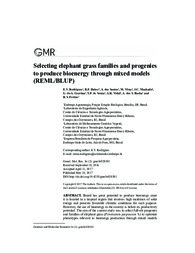Selecting elephant grass families and progenies to produce bioenergy through mixed models (REML/BLUP).
Selecting elephant grass families and progenies to produce bioenergy through mixed models (REML/BLUP).
Author(s): RODRIGUES, E. V.; DAHER, R. F.; SANTOS, A. dos; VIVAS, M.; MACHADO, J. C.; GRAVINA, G. D. A.; SOUZA, Y. P. de; VIDAL, A. K.; ROCHA, A. D. S.; FREITAS, R. S.
Summary: Abstract Brazil has great potential to produce bioenergy since it is located in a tropical region that receives high incidence of solar energy and presents favorable climatic conditions for such purpose. However, the use of bioenergy in the country is below its productivity potential. The aim of the current study was to select full-sib progenies and families of elephant grass (Pennisetum purpureum S.) to optimize phenotypes relevant to bioenergy production through mixed models (REML/BLUP). The circulating diallel-based crossing of ten elephant grass genotypes was performed. An experimental design using the randomized block methodology, with three repetitions, was set to assess both the hybrids and the parents. Each plot comprised 14-m rows, 1.40 m spacing between rows, and 1.40 m spacing between plants. The number of tillers, plant height, culm diameter, fresh biomass production, dry biomass rate, and the dry biomass production were assessed. Genetic-statistical analyses were performed through mixed models (REML/BLUP). The genetic variance in the assessed families was explained through additive genetic effects and dominance genetic effects; the dominance variance was prevalent. Families such as Capim Cana D'África x Guaçu/I.Z.2, Cameroon x Cuba-115, CPAC x Cuba-115, Cameroon x Guaçu/I.Z.2, and IAC-Campinas x CPAC showed the highest dry biomass production. The family derived from the crossing between Cana D'África and Guaçu/I.Z.2 showed the largest number of potential individuals for traits such as plant height, culm diameter, fresh biomass production, dry biomass production, and dry biomass rate. The individual 5 in the family Cana D'África x Guaçu/I.Z.2, planted in blocks 1 and 2, showed the highest dry biomass production.
Publication year: 2017
Types of publication: Journal article
Unit: Embrapa Dairy Cattle
Keywords: Pennisetum purpureum S, biomass production, plant breeding
Observation
Some of Embrapa's publications are published as ePub files. To read them, use or download one of the following free software options to your computer or mobile device. Android: Google Play Books; IOS: iBooks; Windows and Linux: Calibre.
Access other publications
Access the Agricultural Research Database (BDPA) to consult Embrapa's full library collection and records.
Visit Embrapa Bookstore to purchase books and other publications sold by Embrapa.

